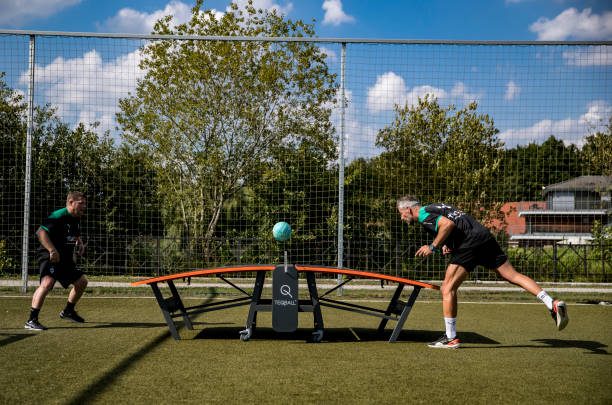
Have you heard of Throwball? This dynamic team sport is like a high-energy fusion of your favorites! Imagine volleyball’s bumping and setting, with a dash of dodgeball‘s throws and agility.
This non-contact ball sport throws a thrilling twist into the mix, demanding quick throws and strategic teamwork to dominate the court.
Throwball shows the similarity of the game with the name. But it’s not similar to a volleyball. If you think that this is just a matter of throwing the ball, then you are wrong.
It is not popular as american football, futsal, cricket, football, or tennis, but it has a different craze in youth and a unique vision. It is not so easy. Often, Throwball and volleyball are confused.
But throw balls are distinct. Several of the sports that are popular and practiced around the globe originated in India. Throwball is one of them. It was first considered a female sport. Throwball is an official game recognized by the International Throwball Federation (ITF).
Later, men and women all over the world played it. It also plays indoors and outdoors. The Throwball Federation Of India (TFI) is the governing body of Throwball.
Do you want to know how do you play throwball?
How to gather throwball skills?
What are the throwball equipments?
How many members in throwball team?
What is the diagram of throw ball court?
Is throwball similar to Volleyball?
What are fouls in throwball?
What is the difference between handball and throwball?
Then you must read the full article.

Table of Contents
History of Throw Ball
Let’s explore the fascinating history of Throwball. In the 1930s, this sport was a popular pastime for women in England and Australia. It was a fun, recreational activity. Then, Throwball made its way to India. The Throwball Federation of India suggests it arrived around 1940, likely through the YMCA.
Interestingly, while played globally, Throwball found its greatest popularity in India. A key figure in this story is Harry Crowe Buck. He founded the YMCA College of Physical Education in Chennai. This institution played a crucial role in the sport’s spread.
Furthermore, in the 1950s, Throwball reached Bangalore. A local sports enthusiast, Ramana, became a driving force. Notably, in 1980, Ramana organized a national Throwball competition. This event significantly boosted the sport’s profile.
Consequently, in 1985, the Throwball Federation of India (TFI) was officially established. In 1990, the federation reached a significant milestone. Throwball became a sport for both men and women in India. This broadened its appeal and solidified its place in Indian sports culture.
Purpose of Throwball
To win, the players must defeat the opposing team. During a Throwball game, there are three sets. The team that can score 15 points first wins the set.
The winning team is the first to win two sets. Throwball is a fast-paced sport. Thus, teams must possess a high level of teamwork and fitness to win.
The Objective of Throwball Skill
- Place a ball along the ground.
- After a ball has bounced, use your forehand to hit it.
- Volley a ball in the air with your forehand.
- To begin a rally, serve a ball.
- Stand up straight, with the ball in your throwing hand and your face to the target.
- Turn 90 degrees to the right if you’re throwing with your right hand.
- Turn 90 degrees to the left if you’re throwing with your left hand.
- Check that your feet are shoulder-width apart.
- Shift your weight to your front foot, lower your pointing arm, and twist your body as you lift your throwing arm over your shoulder to deliver the ball at your target in one move.
Throw ball Skills
Understanding the Fundamentals:
Learn the fundamental rules and regulations of throw ball. Understand the court’s size, the net’s height, and the scoring system.
Team Formation:
The match was played between two teams, each consisting of seven to nine players. There are attackers and defenders on each squad.
Serving:
To begin the rally, a player from one team serves the service ball over the net to the other team. The service must be delivered from behind the end line. Learn various serving styles like the overhand, underhand, and leap serve.
In professional throwball, players are strictly prohibited from jumping while serving the ball, as the serve must be executed with at least one foot remaining in contact with the ground during the entire serving motion.
Receiving (Passing):
To build up an attack, you must pass the ball properly when the opposition team serves it to your team.
To receiving the service ball, concentrate on your hand location and use your forearms.
Launching an attack:
The attacking team’s goal is to put the ball over the net in such a way that the defensive team cannot return it.
Practice your spiking and hitting. Experiment with various spikes such as the power spike, roll spike, and off-speed spike.
Blocking:
At the net, defending players should attempt to prevent the ball as it is spiked by the attacking team.
When blocking to divert the ball back towards the attacking side of the court, timing is key.
Stepping:
For both attacking and defending, good footwork is vital.
Learn how to move rapidly, change directions, and keep your balance while playing throwball.
Communication:
Throwball success depends on effective communication among team members. To coordinate movements and plans throughout the game, use hand gestures or verbal instructions.
Teamwork:
Develop a feeling of trust and teamwork among your coworkers. Understand the strengths and limitations of each player and adjust your plans appropriately.
Strategy for the Game:
Discover offensive and defensive methods such as the rotation system, rotating positions, and establishing a powerful defense.
Fitness and Conditioning:
Improve your physical fitness by working on your strength, endurance, and agility. Conditioning and practice on a regular basis will help you enhance your overall performance.
Game circumstances:
Practice serving under pressure, defending against varied assaults, and performing coordinated attacks in a variety of game circumstances.
Rules and Referee Signals:
Be familiar with throwball rules and referee signals to prevent fouls and penalties.
Scrimmages and Competitions:
Take part in scrimmages and friendly matches to build experience and confidence. Enter local and regional throwball events to put your talents to the test in a competitive atmosphere.
Continuous Improvement:
Never stop learning and developing your talents. Watch professional throwball matches and learn from expert players.
It’s important to remember that perfecting your throwball talents requires time and constant practice. Maintain your focus, collaborate with your teammates, and continue to hone your throwball skills.
Throwball Court Measurement Specifications
When constructing a throwball court, a standard throwball court is larger than a volleyball court. It’s essential to adhere to specific throwball court measurement standards to ensure fair play and optimal conditions for the game. The following details outline the necessary dimensions and markings for a throwball court.
Throwball Court Dimensions
- Width: The width of the throwball court shall be 12.20 meters.
- Length: The length of the court shall be 18.30 meters.
- Half-Court Measurement: This is set at 9.15 meters, marking the center of the court.
Service Zone and Free Area
- Service Zone: Located on the right side of the playing field, the service zone measures 6.10 meters and is delineated by dotted lines.
- Court-Free Area: The area surrounding the court should extend to 12.20 meters, providing ample space for players.
Neutral Zone and Box Area
- The neutral zone or box area is defined by lines that extend 1.50 meters on either side of the court, creating a total length of 3 meters.
- The front zone area, which is also part of the neutral zone, measures 2.55 meters from the box line.

Zone Measurements
- Each zone within the neutral area is designated as follows:
- Front Zone: 2.55 meters
- Center Zone: 2.55 meters
- Back Zone: 2.55 meters
Net Specifications
- The height of the net should be between 2.20 meters and 2.30 meters, ensuring it meets competitive standards.
- The length of the net is set at 12.50 meters, which aligns with the playing surface of 12.20 meters.
- The width of the net is specified as 1 meter.
Antenna and Pole Height
- Each antenna must measure 1.80 meters, with 1 meter extending within the net and an additional 80 cm above the net, marked in contrasting colors such as white and red.
- The height of each pole supporting the net should be set at 2.30 meters.
By following these detailed specifications, you can create a compliant throwball court that meets all necessary standards for play. These precise measurements are crucial for maintaining fairness in competition and enhancing player experience on the court.
Throwball Equipments
A) Pole
- It must measure the height of the poles from the playing surface and must be between 8 and 10 cm. We need white paint and metal poles.
- In the middle of the court, there are 0.50-meter-long poles. Both with their sides away from the court.
- The net is tied to the pole with an additional metal pulley.
B) Net
- Throwball nets must be composed of cotton or nylon and have a length of 12.2 meters and a width of one meter.
- The mesh (Square) should be 10 cm x 10 cm in size.
- The ribbon should be 5 cm thick at the top and bottom of the net in full-length size, and a string should run through it to support the net.

C) The Ball
- The throw ball diagram must be spherical, with a leather or rubber exterior.
- Throw ball diagram should have a circumference of 70 cm to 72 cm when fully inflated, and a weight of 400 grams to 450 grams. It is not heavier balls than soccer but slightly larger than volleyball.
- The TFI will allow only balls with the official emblem in competitions. Technical committee approval is needed if TFI balls are not available. The planning committee If the ball becomes deflated or lost, it may only be replaced for safety reasons.
D) Antenna
- Antennas must be put on both sides of the net, precisely on the sidelines.
- On either side of the net, two 5 cm wide tapes should be fastened. The antenna’s length must be 1.80 m. Long, 10 mm in diameter, and constructed of cane or fiber.
- It should be 80cm above the net.
PLAYERS
- A team must have seven or nine players and three or five substitute players.
- Each additional player’s box is invalid if it contains fewer than seven players.
- Any 12 players can make a substitution at any moment throughout the game.
- The rules allow each side a maximum of five substitutions for each set.
- It should make score sheet entries before the match begins. Players who intend to play or substitute must fill score sheets out.
- The player must wear a suitable uniform with a chest number ranging from 1 to 12 and a size of 20 cm x 10 cm on the back and 5 cm x 2.5 cm on the front.
- Players must abide by the rules and restrictions as outlined.
Rules of Throwball

- Every match should be played over three sets, with the first player scoring 15 points in each set.
- After the referee whistles to signal the start of the game, the service is performed. From behind the opponent’s backline, use any area of the opposing half.
- Only during serving may a point be earned. You cannot double-touch the ball and avoid the ball contact with the ground.
- In throwball, a team loses if they are unable to receive and return the ball after a serve or throw, such as by hitting the net. To successfully catch the ball, you must avoid body contact and contact with the ground while attempting to catch the ball simultaneously.
- You should not volley the ball like in volleyball. They should be caught and then thrown quickly. Release a ball only from above or on the shoulder line.
- In Throwball, players should return the ball to the net as soon as they receive it.
- Two players cannot catch the ball at the same time.
- Catchers must throw the ball back within 3 seconds after receiving it.
- Do not push or misbehave.
- The ball should not come into contact with the net and contact with the ground.
- The rules prohibit players from touching the net for any reason.
- It is not permitted to move the ball from right to left or left to right.
How do You play Throw ball?
The side that wins the toss gets to choose between court and service. There are nine players on each side who must line up in the correct order. A set allows 3 to 5 substitutions for each team, with a maximum of 3 substitutions per team.
Each side in a set may call a time-out at any moment for rest and talk. Every time-out will be 30 seconds long. When you catch the ball, grip it with both hands and swing it towards your right shoulder above your head in a swinging motion (As most of them are right-handed). Then, throw the ball with your arm, ensuring that the ball is thrown with accuracy.

Well, my notion for covering long distances, which I used to recommend to you. Similar to catching the ball simultaneously, run near the net before throwing it a significant distance.
Another option, if you have a lot of practice, is to throw at a 45-degree angle, as you may have seen Javelin throwers do to cover a long distance.
Servers deliver their services behind the backline to any region on the other side. The serving team can only score one point when the opposing team makes a mistake.
Even service follows specific guidelines, such as following the whistle of the referee at the start of the game.
Throwball International
In the late 90s, Throwball gained more popularity among men and women.
The contribution of T. Ramanna lifted Throwball to the International level. He converted TFI to ATF. Kolkata hosted the first Asian Throwball Championship in 2002 to promote the sport internationally.
T Ramanna’s efforts resulted in the creation of the International Throwball Federation in 2002. The ITF’s headquarters are in Bangalore, while the regional office is in South Korea.
Throwball Tournaments
Throwball’s rise is a global phenomenon. While it boasts a massive following in India, its popularity is exploding worldwide. From schoolyards to national championships, India showcases Throwball at every level, with tournaments for all ages and genders. You can even follow the action on the Throwball Federation’s calendar.
But the excitement doesn’t stop there. International competitions are now a regular occurrence, uniting players from different clubs and continents. This surge in global participation underscores Throwball’s growing appeal and the dedication of its players, proving it’s a sport on the move.
Indian National Throwball Championship
The National Throwball Championship is a highlight of India’s sporting calendar. It’s a national showcase of throwball talent, with teams from across the country vying for the championship title. The Throwball Federation of India (TFI) organizes this prestigious event, typically held during the summer months.
The TFI ensures teams have ample preparation time by announcing dates and venues in advance. While cricket and football often take center stage in Indian sports, throwball has a dedicated following, particularly in Maharashtra, Gujarat, and Karnataka.
This championship is crucial for the sport’s growth, providing a stage for players to excel and for scouts to discover future stars for national and international play. It truly embodies the passion and spirit of Indian sports.

Throwball players
We are more enthusiastic about sports stars like football, Cricket, Tennis, Basketball, etc. But we should know that the stars of sports like Throwball, Carrom, Handball and badminton are also amazing enough.
Some throw ball players are Sabiya S, Carmel, Poornima, Aquib Mohamad, Jagat Singh Chauhan, Asif Pasha, Abdul Qadir, Ahmed Lone, etc.
As throwball develops in India, players them will get limelight like the young Indian bowler Arshdeep Singh and will surely play an important part in encouraging future generations.
Mental Conditioning for Throwball Players
Throwball competition requires mental toughness. It distinguishes excellent players from mediocre ones. Here are some tips for developing a winning mindset:
The importance of mental toughness:
- Handling Pressure: High-stakes contests can be nerve-racking. Mental toughness allows players to remain cool and succeed under duress.
- Maintaining Focus: Distractions are prevalent. A strong mind helps players stay focused on the game.
- Coming Back: Mistakes happen. Mental resilience enables athletes to recover quickly and avoid letting errors impair their performance.
- Boosting Confidence: Believing in one’s talents is essential. Mental training increases self-assurance.
Tips to Improve Focus and Manage Game Pressure:
- Visualization: Mentally practice effective plays. This increases confidence and enhances execution.
- Deep Breathing: Deep breathing can help reduce tensions before and during matches.
- Positive Self-Talk: Positive self-talk is replacing negative ideas with positive affirmations.
- Mindfulness: Practice being in the present moment. This lowers anxiety and increases concentration.
- Pre-Game rituals: Develop regular rituals to boost confidence and lessen nerves before the game.
Last Words
Throwball is a dynamic team sport that emphasizes skill, strategy, and teamwork. Players must master essential skills such as catching, serving, and throwing the ball while adhering to specific rules to ensure fair play.
The game is played in sets, with teams aiming to score points through successful rallies. As with darts, precision and timing are crucial in throwball, making it an engaging sport for players and spectators alike. Understanding the rules and honing skills are key to excelling in this exciting game.
Thank you for reading the article so far. I have tried to give you the easiest way to play the Throwball game and overall knowledge in this article.
In the future, I will try to discuss this in more detail and bring something new to you. If you like the article, subscribe to Sports Dribble and its Facebook, Instagram, and Twitter account.
Related Questions
1. What are the Throwball substitutions rules?
Ans:
- Referees use substitutions to allow a player to leave the court while another player fills the same position.
- The referee and umpire must approve substitutions made from the specified substitution area.
- The maximum number of substitutions per team per set is five.
- Referee will allow substitutions during dead ball situations.
- A player can re-enter the game within the same round.
- There was no substitution at the 9th position (service position).
- If a player got injured during the five replacements, the remaining players had to continue with up to seven players.
4. What are the Throwball fouls Rules?
Ans:
- When receiving the ball, the ball slips from the hands.
- If a player touches the ball twice, it is considered a foul.
- Any ball that touches the ground in the free zone box is called a dead ball. As a result, the opposing team scores a point.
- You must not touch any body part while throwing, returning, or receiving.
- A player may not have the ball in their hands for more than three seconds at a time while the game is in progress.
- Another player can receive a ball that rebounds or bounces off the net. However, intentionally sending the ball to the net is a foul.
- Having the service ball touch the net and antenna should result in a side-over.
- It is a foul if the ball is in play and crosses the box line.
- A player who catches the ball simultaneously while taking one step forward or backward makes a superior play. Taking more than one step, however, is a foul.
- Don’t jump to catch the ball, but player can jump to throw it when it’s thrown.
2. Are Handball and Throwball the same?
Ans:
- In Handball, the teams consist of 7 players; a goalkeeper and six outfielders. In Throwball, A team must have seven or nine players and three or five substitutes.
- The player can pass, hold or shoot after receiving possession of the Handball. In Throwball, throwing, returning, and receiving the ball should never touch the body.
- There are three sets in a Throwball match. In a Handball match, each period lasts 30 minutes.
3.Throwball Vs. Volleyball
Ans:
- Nine players play Throwball. Six players play volleyball.
- A cotton or nylon net must measure 12.2 meters in length and 1 meter in width. Men’s volleyball nets are 2.43 meters tall, while women’s volleyball nets are 2.24 meters tall. Height varies according to age and ability level.
- When throwing, returning, or receiving the ball, the ball should never touch any body part. Although players in volleyball often push or strike the ball with their hands or arms (short contact), they are free to utilize any part of their body.
- The playing court measures 12.20 by 18.30 meters (40.03 ft. x 60.04 ft.) with a neutral box of one meter (3 feet 3.37 inches) on either side of the center. A one-meter-wide net divides the 9 m by 18 m (29.5 ft. by 59.1 ft.) volleyball court into equal square halves (39.4 in).
5. What are the kits of the Throwball players?
Ans:
The players must wear a jersey, half pants or skirt, and sports shoes (no heels) made of rubber or leather.
It is against the rules for participants to wear headgear or any other jewelry, including diamonds, pins, and other metallic objects.

My name is Krishanu Das the founder of the Sports Dribble.
I am Accountant by profession but a Sports Blogger by passion.
I am passionate about sharing my all knowledge and experiences of sports, with my readers and every sports enthusiast.
Discover more from SPORTS DRIBBLE
Subscribe to get the latest posts sent to your email.


